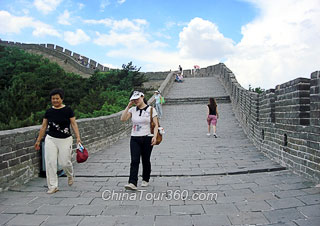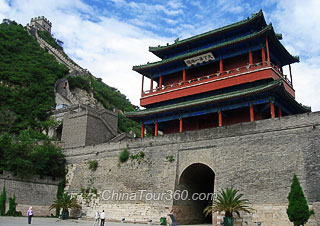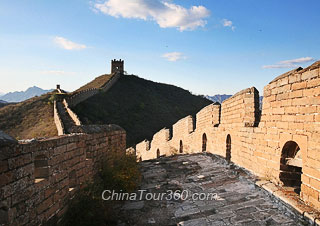 Badaling
Badaling Juyongguan Pass, Beijing
Juyongguan Pass, Beijing Jinshanling, Beijing
Jinshanling, Beijing
When standing on the solid wall and watching it zigzagging along the undulating mountains, you may ask, "Why and when was the great wall of China built?" It dates back to the 7th and 8th century BC. During the Spring and Autumn Periods (770 BC - 476 BC) and the Warring States Periods (476 BC - 221 BC), the feudal states were torn apart into rival principalities. Each state built city walls on their own territories as a defense against the other states. The northern ethnic group was another threat to the states in the middle areas, so walls were also built to prevent the incursion by northern tribes. After Qin Shihuang united the whole country, he ordered the connection of the walls of the Warring States Period and extended it to 10,000 Lis (3,107 miles) to protect the northern border areas as defense against the ethnic tribes. In the Western Han Dynasty (206 BC - 24 AD), the wall was extended to the west (e.g. Dunhuang Han Great Wall) to keep the Huns out and safeguard the Silk Road. The last time it underwent a large scale reconstruction was in the Ming Dynasty (1368 - 1644), when the Yuan Dynasty (1271 - 1368) was defeated and the new power was established. The central government of the Ming Dynasty ordered the construction of the wall to prevent the Mongolians from staging a comeback. Over 200 years reign of the Ming Dynasty, the wall stretched for 6,000 km (3,728 miles) from Yalu River in Liaoning Province to Jiayuguan Pass in Gansu Province. The Great Walls in Beijing were mostly built in the Ming Dynasty.
In addition to the military function of as a defense against invasion and protecting territories, the wall also had great influence upon other aspects of the national economy and culture:
![]() Opening up wasteland and safeguarding the farmland in the border areas. The Great Wall builders, garrisons and their family members lived along the wall developed wasteland for farming to ensure supplies. At the same time, it became the natural fence of the farmland. In the Qin Dynasty (221BC - 207BC), Qin Shihuang set 12 shires along the wall and sent immigrants to the areas. Later in the Western Han Dynasty, Han Wudi paid much attention to the development of agriculture in the border areas.
Opening up wasteland and safeguarding the farmland in the border areas. The Great Wall builders, garrisons and their family members lived along the wall developed wasteland for farming to ensure supplies. At the same time, it became the natural fence of the farmland. In the Qin Dynasty (221BC - 207BC), Qin Shihuang set 12 shires along the wall and sent immigrants to the areas. Later in the Western Han Dynasty, Han Wudi paid much attention to the development of agriculture in the border areas.
![]() Promoting cultural and economic interchange in the border areas. Early in the Warring States Period, the Wall of the Qi State was the important gateway for the trade with other states. In the Qin Dynasty, broad passages were built along the wall and all the way to the capital, providing convenient paths for merchants and messengers. Later in the Western Han Dynasty, the passes, towns, castles and towers provided shelter for the ambassadors and businessmen on the Silk Road.
Promoting cultural and economic interchange in the border areas. Early in the Warring States Period, the Wall of the Qi State was the important gateway for the trade with other states. In the Qin Dynasty, broad passages were built along the wall and all the way to the capital, providing convenient paths for merchants and messengers. Later in the Western Han Dynasty, the passes, towns, castles and towers provided shelter for the ambassadors and businessmen on the Silk Road.
![]() It has inspired many famous work of literature, such as the Legend of Mengjiangnü, the Legend of Beacon Towers, poems, and paintings.
It has inspired many famous work of literature, such as the Legend of Mengjiangnü, the Legend of Beacon Towers, poems, and paintings.
![]() Nowadays it is not only a famous historical relic but is also a precious source for the study of Chinese traditional architecture. It attracts thousands of visitors each year from both home and abroad as in rightly recognized as one of the wonders of the world.
Nowadays it is not only a famous historical relic but is also a precious source for the study of Chinese traditional architecture. It attracts thousands of visitors each year from both home and abroad as in rightly recognized as one of the wonders of the world.
![]() Tip: How did the defensive system work?
Tip: How did the defensive system work?
The defensive system of the Great Wall was comprised of four parts. The first was the garrison system, which was the major defensive power. The garrison system included the walls, passes, castles, and towns where the troops stationed. The second was the beacon towers, which were used to send military messages. The third was the station or post system, including the post houses and transit stations for the messengers and passing-by officers, and the supply points. The fourth was the military supplies system, referring to the farmlands, salt factories, smelters and trade markets which providing supplies for the troops. When enemies approached, warning messages would be sent from the beacon towers and post houses or stations, so that the garrison troops could get ready to repel any attack.







